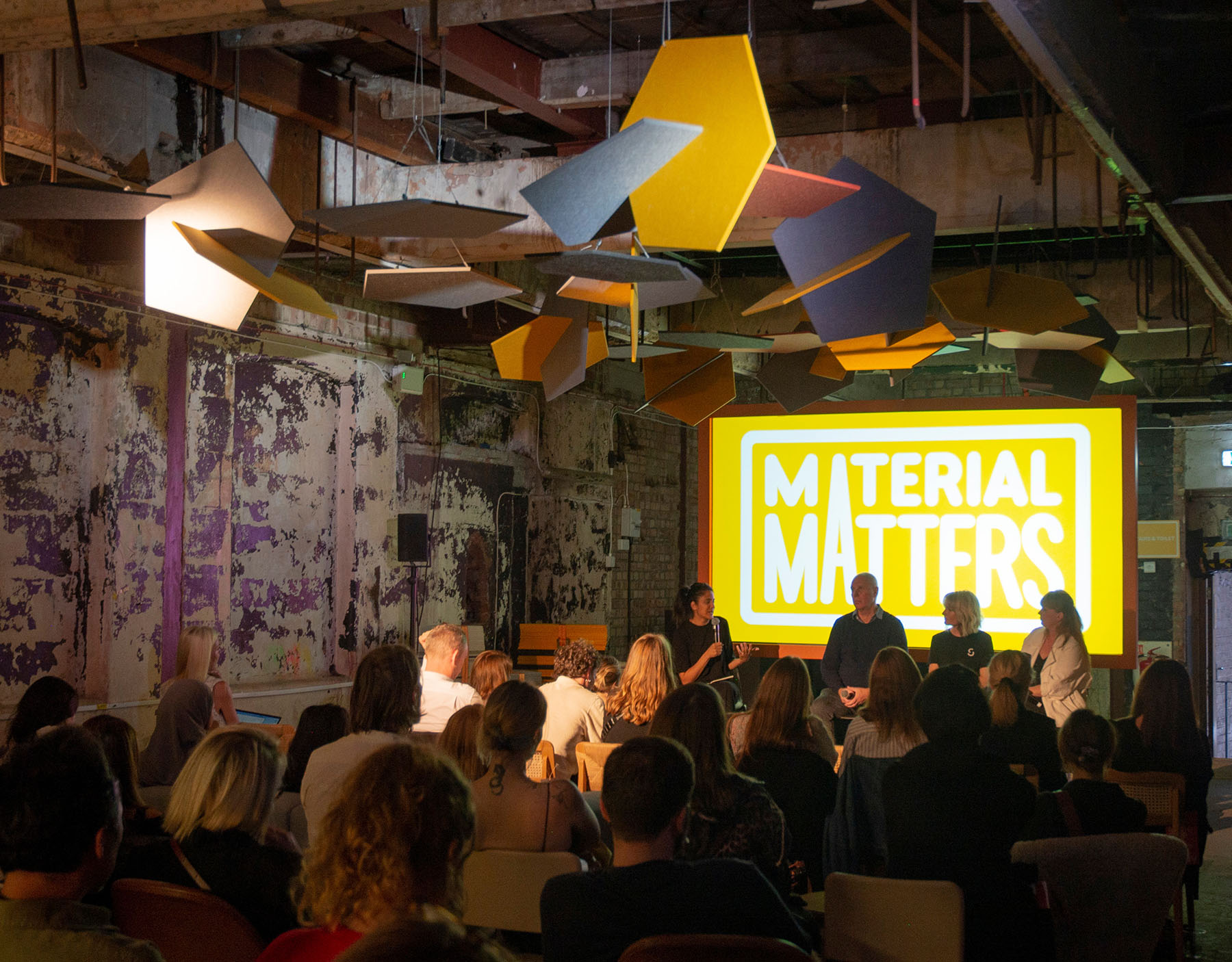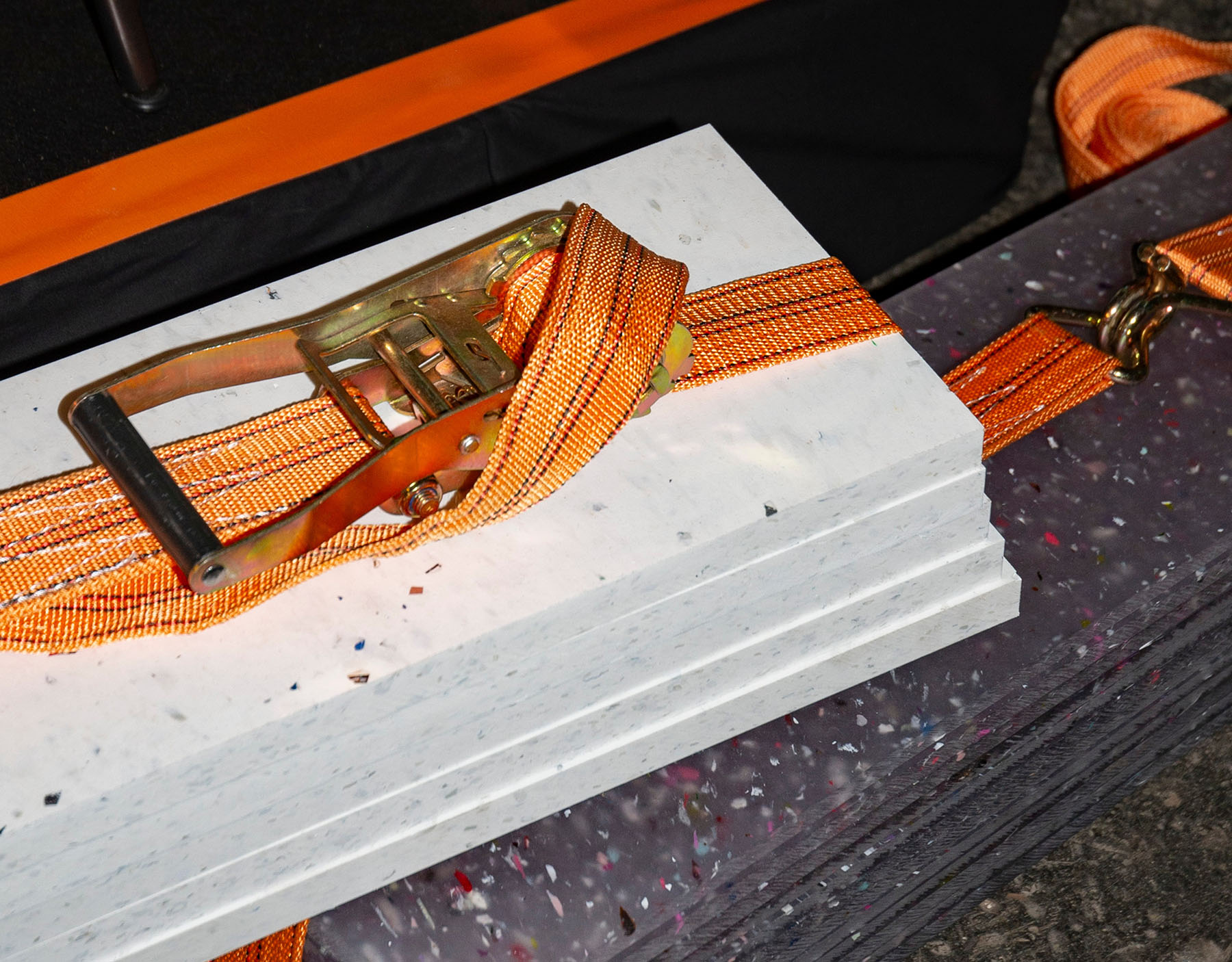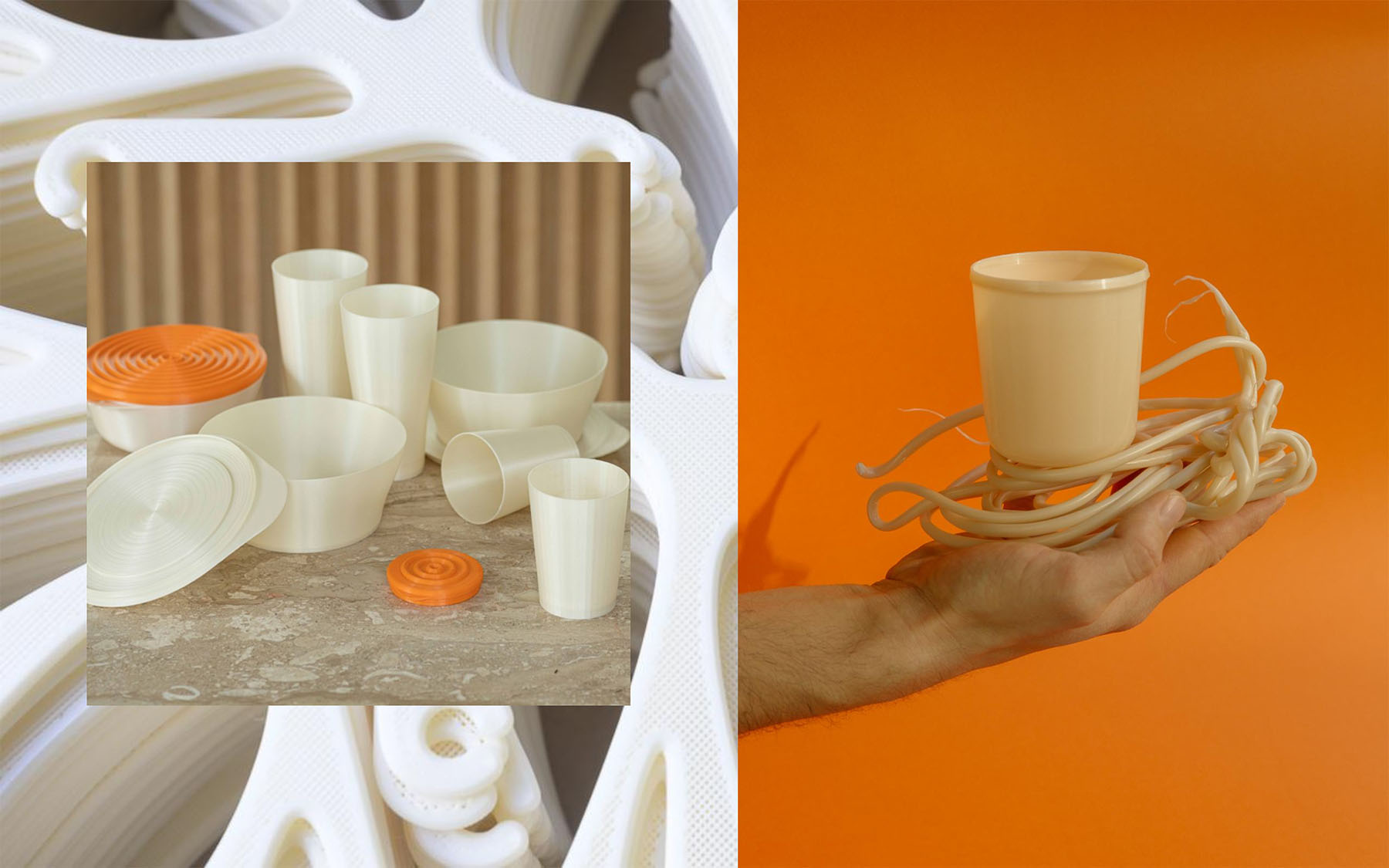
Plastic has had a bad reputation, but a new generation of designers and manufacturers are discovering its potential. Life in Plastic asks: is it time we re-think the material?
For the latest in our Plastics Unpackaged series, we uncover some of the highlights from the Life in Plastic discussion that took place at Material Matters during the London Design Festival 2022.
Featuring our own project manager, Emily Skinner, alongside Vlasta Kubušová, co-founder, crafting plastics! Studio and Håkan Nordin, head of sustainability, Bolon, the conversation was chaired by writer and curator Riya Patel, and sought to highlight the benefits and challenges associated with plastic as a viable material, both now and into the future.
Kicking off the discussion was a question from Riya about plastic’s aesthetic appeal for contemporary product design. “What struck me about all your images [on screen] was how beautiful they all were, and how the aesthetic of recycled plastic or alternative plastics has reached a point now where it is very desirable and fits in with many different types of projects. It's up there as the material that everyone wants to specify. So, I wondered what the role of the designer is in rebranding plastic from something cheap and disposable to something very valuable, very durable, very aesthetically interesting, and, also, how we help reform our problematic relationship with plastic?”
“For us, the aesthetic and the design element is central to our mission to make the most beautiful surface panels out of 100% recycled plastic”, answered Emily. “And it's a key component because it has to look desirable to be desired to then make a change in our behavioural consumption habits. And by doing that, we're hoping that something that has been viewed as disposable or valueless can suddenly create a thought change."
“In the 1960s, plastics was the wonder material, and that hasn't changed. But the way that we've used it over this time has changed our perception of it. Plastic can be reused again and again and again. There’s so much value in that. We must value the material to then change how we interact with it as consumers. And we feel it's the job of the designers to make that happen.”
Does the same desirability apply to bioplastics as it does recycled material? Vlasta believes it also comes down to perceived value. “We often get asked by collaborators and clients, how can you see that this is actually bioplastic?” With their own collections, Vlasta explains that aesthetics play a big role in the value perception, as well as other sensory qualities including retaining the material’s original smell so it can be distinguished from fossil fuel based plastics. “I totally understand that from people who are not so involved in the topic as we are, they cannot find the value just by us saying this is equal to this. And currently, it’s also a more expensive option. But we’re working on this very consciously in order to change perceptions.”
Håkan’s view is that while “plastic is fantastic”, negativity around the way it’s been used has overtaken the positive credentials of the material itself. “It’s a wonder material. It’s light, strong and easy to produce. Overall, it is good for society. If you have 200kg of plastic in a car, it makes the car lighter, which means it’ll use less petrol. Having said that, there is more plastic than fish in the sea. And we have disposable plastic coming from oil, which is bad for climate change, and so on. It’s tricky. From our side we are making a top product from polymers and plastic, and we are proud of using the plastic because it makes the life span of our floors excellent. The temperature to make the floor is also very low, 200 degrees. So, while it’s horrible to see the sea plastic and throwaway items coming from oil, from clothes to cars to computers - we’ve always used plastic, but we don’t necessarily always think of it as being plastic.”
A circular approach
Following on from Håkan’s point, to change the general consumer perception of plastic as a material, we must first review our systems of use – the reuse of plastic needs to be kept in a loop.
At Bolon, Håkan said recycled plastics feed into their manufacturing process via a dedicated recycling centre. “With flooring, 70% of the weight is the backside, which you don’t see. Here it is very easy to work with recycled material. So that’s where we started. And the challenge for us now is to increase it to other parts of the product.”
However, the target isn’t so easy to hit with outside sourcing proving a problem. “As a company we need just 1,000 tons of recycling material per year, and it's hard to source it. Soon we will need 2,000 or 3,000 tons because we are growing. We also realise that using recycled material isn’t enough. We need to make our floors a new resource too.”

The sourcing of waste material for recycling is a challenge we also face at Smile Plastics, as Emily explained: “The market over the past 18-months has become incredibly competitive, hopefully, that’s a wonderful thing because it means people are swapping virgin materials for recycled. Smile has always used 100% recycled materials since its inception in the ‘90s where any type of recycled material was bound together. But since Rosalie and Adam took it over and relaunched in 2015, the key criteria has been that the panels are made from only 100% recycled material and they are also 100% recyclable. It's using singular polymer per product which makes them that way.”
Though this approach has not come without its difficulties. “When you make something beautiful, people want it to look the same all the time. And that is not the way that the recycling industry works. Because the story of its previous life to how it's been processed ready for us, changes the appearance of the panels as they come out. So, there are many variables, but that’s part of its beauty.”
“Seeing its previous life, seeing that it's got the foils of the yogurt pot within it, actually adds to its aesthetic” – Emily Skinner, Smile Plastics
Rewriting the narrative
As Emily summarised, at Smile, we’re advocates of reviving society’s emotional connection to plastic, that there are a multitude of solutions which Smile are a small part of. Riya proposed that “in the story of plastic development, we got to the wonder material and then we somehow stopped playing or experimenting with what it could be.” In the 2020s, are bio and recycled plastics the key in reengaging consumer interest?
Vlasta said that the idea of creating a sensory narrative tied directly back into this. “We started to experiment with coffee waste for our bioplastic materials, and after two years, the samples still smell like coffee. And they smell so beautiful and different to all the other materials and we thought ‘why aren’t we using this as a feature?’ Because if then whoever encounters the material and is able to come closer, smell it, think about what it is, it will really change the way they see the material.”
And the same goes for the rich and varied narrative of recycled plastics, which often also include unexpected sensory elements. Emily shared, “some of our ‘waste’ material has also come with a unique smell such as chocolate from its previous life. This is the type of thing that we believe should be celebrated.”

An education
“I feel like we’re at a point where we know the way we’ve used plastic is a problem”, commented Riya, “and I wondered if through conversations with clients or collaborators there’s still an education needed around better choices?”
“Of course, we need it when selling flooring”, answered Håkan, “but we have to identify the quality we’re bringing in through using recycled plastic i.e., the design, the lifespan – all that you can do with plastic. We are selling it as a solution to reduce climate impact and promote circularity, and it works, it’s what customers are asking for.”
Emily added: “For us, provenance is also crucial. Plus, we monitor the carbon impact of our processing of this material, so looking at how far we’ve had to go to get it and building relationships with local recycling facilities to say we need it supplied in this way for us. As we grow regionally and internationally it’s then looking at the local environmental detriments of plastic in those areas, and establishing the opportunities for supply because we need to buy in large tonnage volumes – the demand is certainly there.”
Of bioplastics, Vlasta said: “We are changing the source of the origin of plastics and that can take some getting used to, but in our case, a time will come when these materials become widely accepted and understood. Currently we are mostly working with brands or clients who want to be pioneers in this. But in order to replace all plastic with something like what we are doing, it will take time to implement it, to create the policy strategies and infrastructure for bioplastics, but that’s another story.”
Much research is being undertaken by the company to ensure clear communication, and the avoidance of ‘green washing’. “What I’ve learned is to simplify the way we describe what we are doing”.
So, what does the future of plastic look like? What will it take for the adoption of recycled plastic on a mass scale?
“I think big business has difficulty sourcing it”, answered Håkan. “We as a small player have difficulty obtaining recycled material. We could use much more but we don't because we need to find it in the right quality with the right content - you really need to find good sourcing and reliable deliveries and that's a challenge. The marketplace for recycled material is not there.”
“At Smile we have exactly the same problem, and we’re even smaller”, agreed Emily. “Though this doesn’t mean to say it can’t be taken on by others – any step is only going to be a step in the right direction. And there’s plenty we can do with our behavioural habits to make a small difference. A small difference in a big company is a huge difference.
“A multifaceted approach is needed as every angle is relevant and necessary, from bioplastics to recycling, but it will all be dependent on the infrastructure around each value supply chain so that the ability to convert them into a new life is accessible for everyone, regardless of size.”
Many thanks to Material Matters for inviting us to take part in the Life in Plastics discussion, we very much enjoyed sharing our views on this fascinating and hugely important topic.
Read more from our Plastics Unpackaged series above and join in the debate by tagging @SmilePlastics on social media.